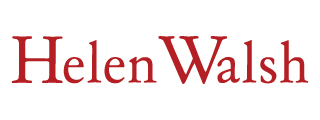Anna Maria Island.
Ever heard of Anna Maria Island? I hadn’t either until my friend Susan let me in on this secret ‘old Florida’ gem that flies mostly under the radar screen.
That is bound to change with magazines like Travel + Leisure naming it to the 2024 Must-Visit lists, although fingers crossed local council seems determined to preserve its essential unspoiled nature.
AMI is the most northern of a string of barrier islands near Sarasota that run down the gulf side to the Florida Keys. Immediately to its south is Longboat Key, AMI’s anti-Christ with its mega-mansions, gated communities and serial Lamborghinis. Below that is Siesta Key, favourite of the partiers and home to many writers over the years, including famed crime novelist John D MacDonald who I loved to read growing up.
And Casey Key – a smidge south – is home to Stephen King. South Florida’s “languid sleaze, racy sense of promise and breath-grabbing beauty” is apparently irresistible to the scribe.
There are no large condos or hotels to block views of the water on Anna Maria Island. No private beaches. No chain restaurants. There are, however, seven miles of glorious powdery white sand beaches to walk, with turquoise waters and pretty amazing sunsets.
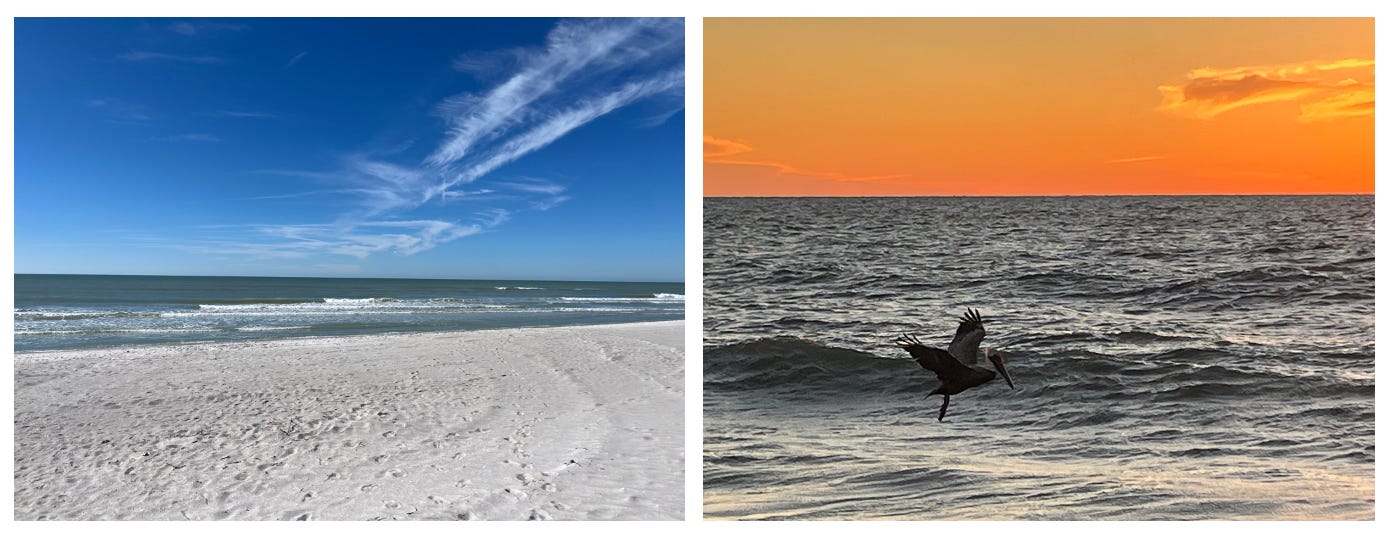
I went to Florida because, let’s be honest, sometimes you want the holiday equivalent of a nice bowl of pasta. Comforting, familiar and nothing that’s going to rock your boat. Roads you can cruise along with your window down listening to Jimmy Buffett’s ‘gulf and western’ songs about booze and sex, knowing you should cringe at some of those ‘70s lyrics. But singing along about your lost shaker of salt, regardless.
Turns out, Anna Maria Island is so much more than easily digestible. And it got me thinking yet again about how travel can shake us out of preconceptions and safely held opinions, if we let it.
The speed limit on this sliver of an island is 25mph, but almost no-one works themselves up to that. A free trolley ferries passengers from tip to tail; there’s also rental bikes and golf carts, nature trails and old-style piers that beg to be ambled along or fished off.
A community theatre group – The Island Players – offers a full season to its residents and visitors. I enjoyed an evening watching that old Agatha Christie chestnut The Mousetrap in its lovely purpose-built theatre, whose enthusiastic embrace by its sold-out audience was moving.
I kayaked a little further north at Shell Key Preserve, an 1,828-acre archipelago that is an extraordinary place to see birds – including two bald eagles that soared above us as we cut across the water – and other wildlife.
For all its shopping malls and wacko politicians, Florida is also abundant with nature, and efforts to preserve it. Thousands of miles of ocean coastline and tidal shorelines, marshes and mangroves, freshwater wetlands and springs. There are massive parks, preserves, trails, bird sanctuaries and wildlife refuges to visit. They make it easy for you to be as active as you want to be.
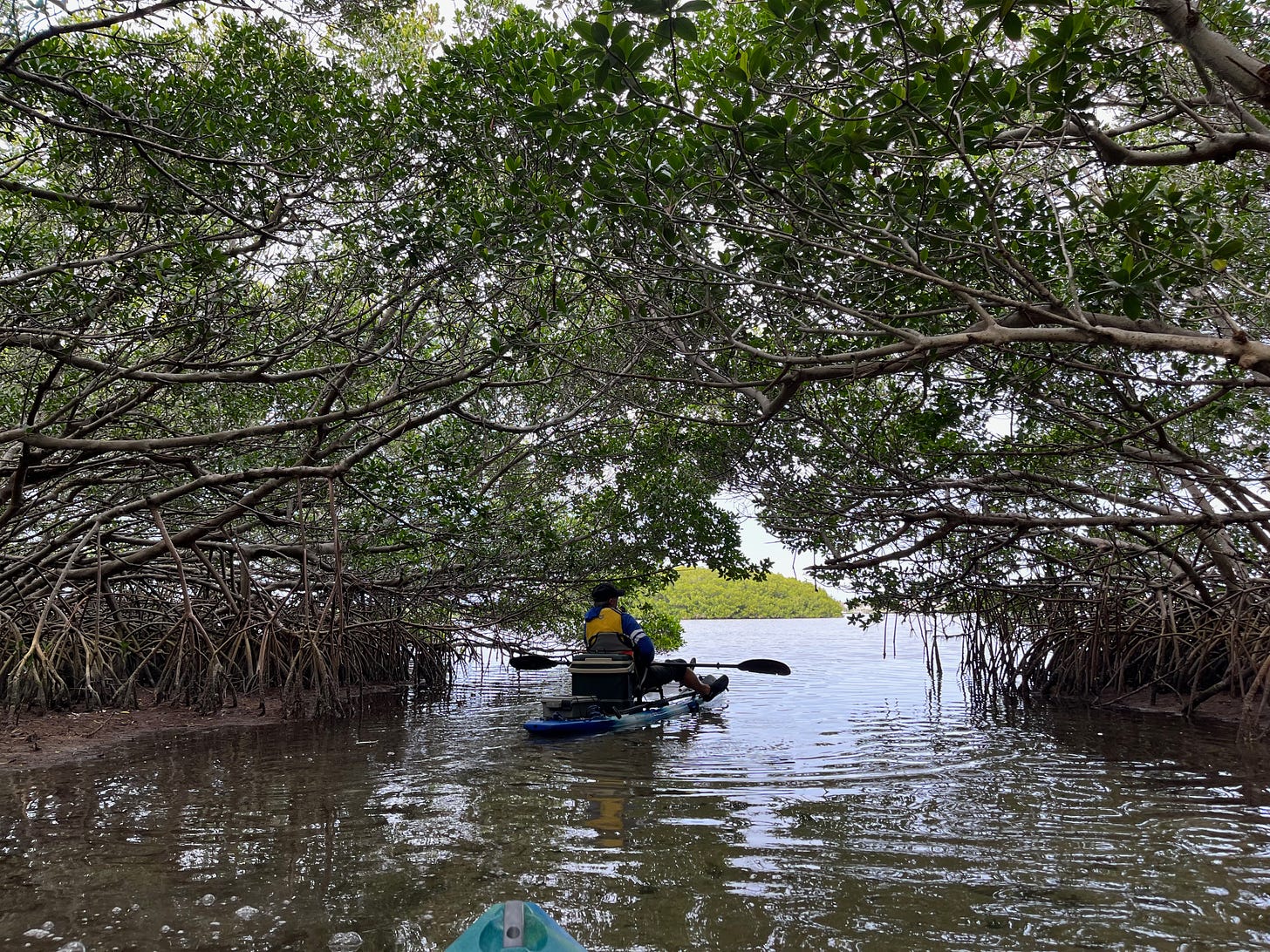
Ringling Bros.
Sarasota is an undisputed cultural centre with theatre, opera, symphony, ballet, art museums and restaurants. It’s also circus country – arguably the single most dominant form of entertainment in America at a time before multiple screens began to compete for our attention.
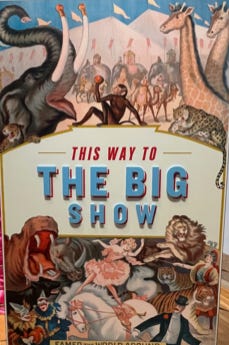
In 1884, the 5 Ringling brothers – Albert, Otto, Alfred, Charles and John – of Bariboo, Wisconsin were determined to start their own circus, at first performing in a vacant lot across from their town’s square, under a homemade tent held up by poles and stakes cut from the nearby woods.
(Circus itself was first brought to the US from the UK in 1793 by John Bill Ricketts. Hachaliah Bailey established one of the earliest American circuses around 1806.)
The Ringling Bros was a great success despite their lack of animals. Instead, they had contortionists, balancers, comedy acts, tumblers, jugglers and lots of music, with the brothers doing most of the performing.
By the following year, they began to tour as the Ringling Brothers: Great Double Shows, Circus Caravan and Trained Animal Exposition, with the addition of a bandwagon, and a museum tent filled with stuffed parrots and a collection of live songbirds and small animals. The show grew quickly: by 1891 they’d expanded the big top to present three rings and were touring by rail.
For almost a hundred years from the 1850s, circus ruled as America’s most popular form of entertainment. It ranked right up there with Thanksgiving, Christmas and the Fourth of July – people emptied onto the street to watch the animals and performers roll into town.
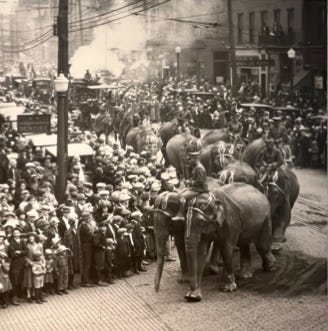
In the 1890s, Barney and Bailey’s “Greatest Show on Earth” was the largest circus. But when James Bailey decided in 1897 to travel his show in Europe for five years, he underestimated the growing popularity of the Ringling circus. Upon his return, he faced a formidable competitor; when Bailey died in 1906, the Ringling Bros bought out their biggest rival.
By 1919, labour shortages and complications to rail travel brought about by WWI prompted Ringling to start touring the two circuses together. It was an enormous undertaking – more than 1,100 employees, 735 horses and almost 1,000 other animals travelling in 90-100 double length rail cars.
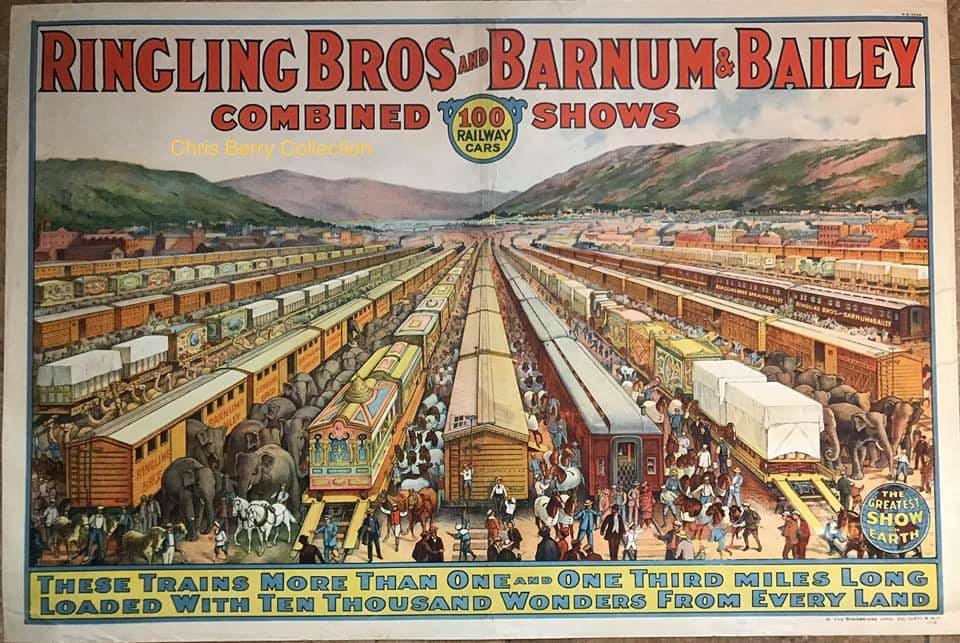
So, why Sarasota? In 1904, John Ringling and his wife Mable bought a private railcar from Pullman they named “The Wisconsin” after his home state. In 1912, the couple first travelled to Sarasota and fell in love with the area. As importantly, John saw enormous potential in the undeveloped state, and bought huge amounts of real estate, which made him a fortune. Others followed suit.
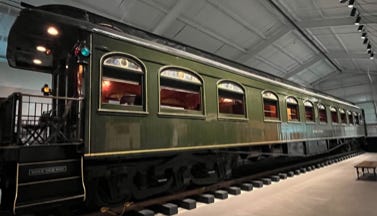
In 1927, they moved the winter home for the circus to Sarasota, an enormous economic boom to the city. They bought a estate on the water and built an ornate 32-room home they called Ca’d’zan (Venetian for ‘house of John’). They also erected a pink Italianate building reminiscent of a Renaissance palazzo to house their extensive art collection (including many works by Peter Paul Rubens, Poussin and Van Dyck) as well as the Astor’s music and dining rooms when their NYC mansion was torn down.
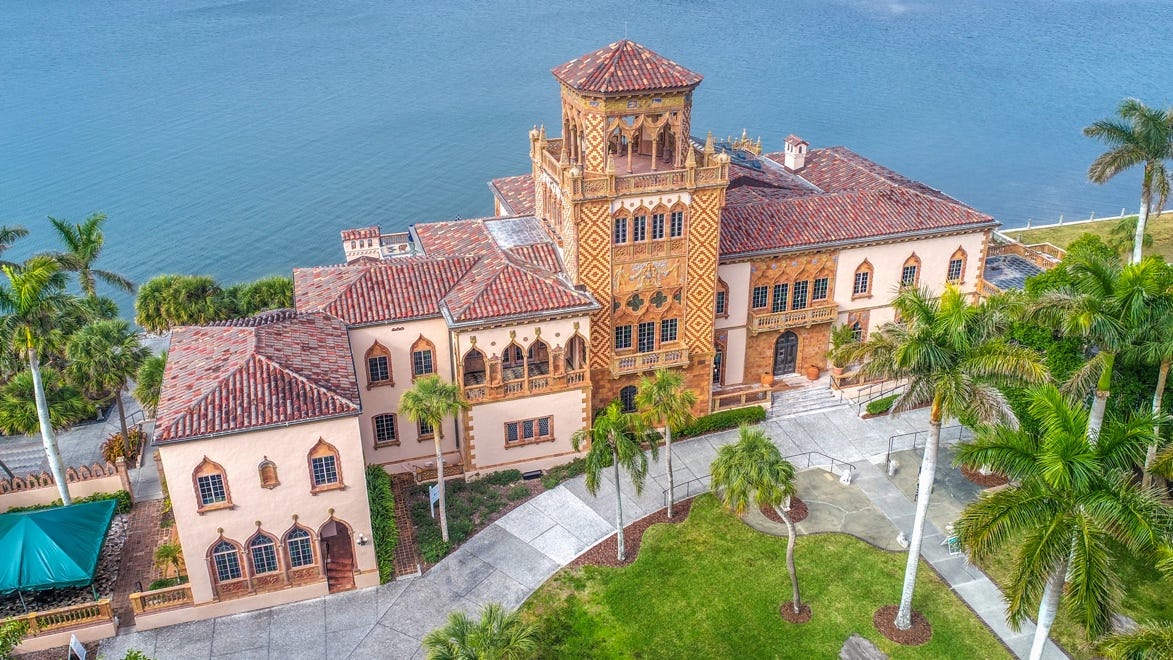
When John Ringling died in 1936, he continued his record of philanthropy to Sarasota by gifting the 66-acre estate and everything in it to the city.
Bread and Circuses.
The term ‘Bread and Circuses’ is attributed to Juvenal, a Roman poet active in the late first and early second century AD. People allow themselves to be diverted from important matters, he argued, when given opiates like bread and circus juggling acts to keep them appeased and docile.
Humankind sitting in superior judgement of others is nothing new.
The reality is bread is tasty, and circuses are fun. And popularity carries its own legitimacy. Our 20th century sensibilities recognize the human and animal rights abuses that happened in early circuses, and we should be thankful to the activism that cleaned them up.
At the same time, circus provided a home and sense of family to tens of thousands of performers over the years. It helped ordinary people survive a civil war, two world wars and a great depression, among other world events.
In truth, I’d never thought too closely about circuses before I visited Sarasota and Anna Maria Island. I’d gone once or twice as a child; and as an adult, I often buy tickets to the human circuses programmed into the Edinburgh Fringe Festival. The storytelling artistry and breath-taking physical skills are second to none, and I enjoy them as I would any other kind of physical theatre.
It can sometimes seem these days that we live in a puritanical age where holding a strong or overwhelming opinion somehow equates to objective truth, and thus can never be legitimately questioned. We’ve also seen a distressing return of book-banning and blacklisting, often under the guise of ‘community standards’ or ‘community accountability.’
Everywhere, and in everyone, there is more than meets the initial gaze. Contradictions and dichotomies; the weird and the wacky, the silly and the profound. Thank goodness, yes? To dismiss complexity in favour of rigidity is one reason for this war-torn, challenged world of ours.
Humans differentiate from other species due to our capacity for nested scenario building, which allows us to imagine several alternative situations and embed them into a larger narrative of connected events. And because we have an urge to connect, to exchange thoughts with others, to achieve more together than we can apart.
So here’s to more bread (preferably whole-grain!) and a circus of riotous and contradictory opinion through which we may challenge each other and grow.
Circus Films.
Cecil B DeMille’s 1952 classic, The Greatest Show on Earth, won the Oscar for Best Picture. It starred Charlton Heston, Jimmy Stewart and Dorothy Lamour, along with the real Ringling Bros and Barnum and Bailey’s circus troupe of 1,400 people, hundreds of animals and 50 railroad cars of equipment and tents. The film premiered in Sarasota, at what is now the Sarasota Opera House.
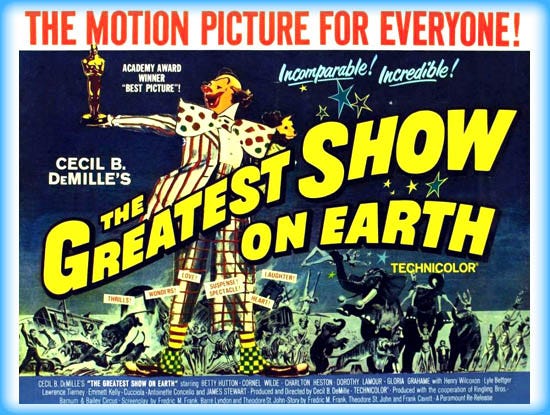
It was the first movie Steven Spielberg ever saw; he credits it as a major inspiration for his film career. The movie got its fair share of criticism, especially winning the Oscar against such films as High Noon, The Quiet Man, and Ivanhoe.
Some argue it won because of the McCarthyite political climate in Hollywood at the time; DeMille was a Republican while the producer of High Noon would soon find himself on the blacklist, as would one of the Ivanhoe writers. Others argued it was the last chance for DeMille to win a competitive Oscar, given his best work had been done in the silent film era. Either way, controversy surrounding the Oscars’ nomination list continues.
Another circus film was the 2017 The Greatest Showman starring Hugh Jackman, Zac Efron, Michelle Williams, Rebecca Ferguson, and Zendaya based on the life story of P.T. Barnum. That film gained a cult following, bofo box office, and nominations and wins at the Golden Globes and Oscars.
Reading South Florida.
The wild and weird of Florida permeates every Carl Hiassen book, along with side-splitting humour, eccentric characters and pointed messages about environmentalism, political corruption and over development.
I also highly recommend The Orchid Thief by Susan Orelan, based on her two-year investigation of the arrest of plant dealer John Laroche and a group from the Seminole First Nation for poaching rare orchids in the Fakahatchee Strange State Preserve. Then there’s the strange and wonderful Charlie Kaufman film, Adaptation, where Nicholas Cage plays a fictionalized Kaufman trying to adapt Orlean’s book.
As mentioned above, author John D MacDonald (Travis McGee series) lived on Siesta Key and used local places liberally in his work. Carl Hiaasen says of MacDonald that he was “the first modern writer to nail Florida dead-center, to capture all its languid sleaze, racy sense of promise and breath-grabbing beauty.”
Crime writer Ed McBain lived in Sarasota for many years and set his Matthew Hope series is his adopted city, as did Stuart Kaminsky with his Lew Fonesca books.
And Stephen King – possibly Sarasota’s most famous resident, albeit very private – wrote about a fictionalized version of Casey Key, where he now lives part-time. He first came to Florida to recover from a near fatal accident that left him addicted to painkillers, an experience which clearly influences the novel.
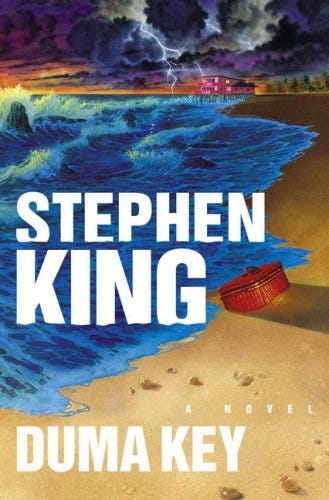
Bye for now. Thank you for joining me for this twenty-sixth edition of Letterbox.
